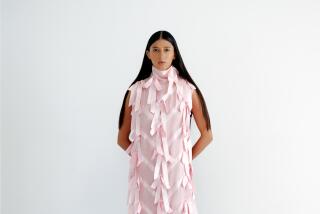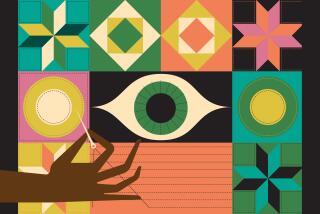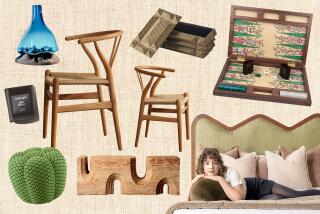DECORATING : Frothy Fabric Becomes Fashionable Again
- Share via
Ursula Stauss is a solid, sensible-looking German woman. She wears her hair short, in a brushed-back style, and doesn’t bother to hide the gray. She favors glasses over contacts. You would hardly call her the frivolous type. Yet her store, Ursula’s European Creations in Fullerton, contains a $50,000 inventory of that exquisitely frivolous fabric: lace. She’s rather an expert on the subject.
Becky Strang doesn’t look like the lacy type either. She worked as a forklift operator at the Wesson Oil Refinery in Fullerton for 15 years before it closed, and she’s the one who does the family yard work, paints the house and climbs ladders to hang Christmas lights.
Strang’s love of physical labor (“It keeps the blood moving”) shows in her lean, wiry physique. It’s easy to imagine her busting broncos as the female star of the rodeo. But that tough, trim body harbors a romantic soul. The woman’s house is absolutely lace-drenched.
Beginning with comparative restraint in the dining room, where balloon shades made of crisp, ivory lace soften the view of the street view through a picture window, the theme builds to a crescendo. Gathering momentum with each room, it explodes into full fantasy in Strang’s guest bedroom--a frothy confection of peach satin and rose-patterned lace fit for a fairy-tale princess.
If neither Strang nor Stauss fits our stereotypes of lace lovers, the fabric itself holds surprises too. It seems a good time to investigate because lace is fashionable again.
Home decor was very masculine and minimalist in the ‘70s, says Andrea Holte Hymer, an interior designer in Orange. “But we’re moving away from that,” she notes. “The trend is toward more decoration--fringe, embroidery, pattern, details. And lace fits right in with that mood.”
Now that people are spending more time at home, Hymer says, they want a cozier setting than matte black metal and gray industrial carpeting can furnish. “They want a softer, more welcoming look,” she says. “It’s part of the cocooning thing.”
Lace is also complementary to the country decorating motifs that are enjoying popularity. “French country is still strong,” says Susie Kusinsky, sales manager at Pringle Draperies, a lace specialist in Anaheim, “and lace has always been associated with that style. It goes well with the pale woods, dusty rose and French blue colors, and floral prints.”
It’s also a natural component of the English country style, which designers like Ralph Lauren and Laura Ashley favor, according to Jan West, market manager at Westminster Lace, a lace specialty shop in South Coast Plaza. “Lace curtains and white-on-white beds (layer after layer of lace-trimmed linens) are perfect foils for all that chintz,” she says.
Strang would agree with both women. “Lace has always meant country to me,” she says.
Part of the appeal of country styles may be nostalgia for a more leisurely paced age when households had more time for amenities, but upkeep--on the lace component of these decors, at least--is surprisingly minimal.
Most lace today is machine-made and 100% polyester. It stands up to machine washing and drying and needs no ironing, according to Stauss. If you use the European drapery system her store favors, you don’t even have to remove and replace drapery hooks from the fabric during laundering.
Rather than employing familiar drapery rods, the German-manufactured hardware system that Stauss employs consists of slot boards that are either mounted flat on the ceiling or from brackets. Tiny plastic rollers sewn directly into the drapery fabric slide into these slots. The rollers are permanent and aren’t removed when the drapes are laundered.
Even the more traditional 95%-cotton, 5%-polyester laces found at Westminster Lace stores aren’t that difficult to care for, West says. “I have several styles in my own home,” she says. “I stick them in the washer and put kitchen knives in the hems when I hang them up to dry. The weight pulls the wrinkles out, and they dry perfectly straight. You never have to press them.”
Though lace was originally a fabric that only royalty could afford, modern, machine-made lace is comparatively inexpensive. “We did a whole house in Pasadena with $700 worth of yardage,” West says.
Lace is generally less expensive per yard than heavier drapery fabric to begin with. Another cost-reducing factor is that some experts and stores that specialize in selling it--Westminster Lace among them--suggest using no more yardage than twice window-width. “And many customers prefer flat panels,” West says.
Most fabric shops and decorators (Pringle included) recommend using three to four times the window width, even for lace. But the less fabric you use, the more the lace pattern shows and the prettier the effect, West says. “We pay a fortune for our views out here,” she says. “Most people don’t really want to hide them, just dress them up a little.”
If privacy is more of a consideration, there are still plenty of ways to utilize lace, according to Kusinsky at Pringle. You can hang pleated shades behind regular lace curtains. “That’s a soft pretty look. And when the shades are rolled up, you hardly notice them. They’re very compact.”
Lace can also be used as an overlay over antique satin or other solids, she says. “And some people put lace on a separate rod--the lace in front and a solid, privacy solid behind--just like hotels use black-out drapes.”
Even apartment owners are investing in lace, according to Linda Migge, manager of W-R-Fabrics in Mission Viejo. “Lots of people are using lace to soften Levelors (mini-blinds),” she says.
One of the easiest ways, according to Migge, is by creating quick tie-backs using two sets of infinity rings. Infinity rings are sets of double rings that attach to wall hooks placed on either side of the window a few inches above the opening. Whether you employ one or both rings, the amount of fabric you pull through each determines whether you create bows, poufs or an effect called a bishop’s sleeve.
“You don’t need a decorator or a drapery maker to use infinity rings,” Migge says. “You can easily do it yourself.”
If you use lace with prescalloped borders, it’s even simpler, she says. “All you have to do then is calculate the length you need and sew a hem on the bottom on each side. That’s it. It’s quick, easy and portable. You can even take the lace with you and use it again in your next apartment or home.”
Infinity rings are also an inexpensive way to create a canopy effect behind a bed, Migge says.
An even simpler way to soften mini-blinds, she says, is to drape a length of lace over a drapery rod in several large scallops. “There’s nothing to it, but it adds an element of decoration without costing a bundle.”
Fabric manufacturers are also making it easier for people to use lace by coming up with new patterns that are more compatible with many contemporary settings than the traditional floral and medallion motifs. Hymer, for instance, recently used an oak-leaf patterned lace in a client’s music room.
“The husband likes looking through it to the back yard,” she says. “He says it’s almost like looking through a grove.”
Janet and Frank Lee found lace in a California poppy pattern at Pringle and use it along with tie-backs and valance in a complementary cotton print of impressionistic poppies in the living room of their new home in Anaheim Hills.
The dominant pale blue in the cotton print matches the room’s carpeting and coordinates well with its antique furniture and pastel-covered furniture. It’s a look that’s a little more formal than many contemporary interiors but--because of the poppy patterns chosen--still looks very Californian.
The Lees’ home demonstrates that there’s still room for lace--that most traditional of fabrics--to be used in brand new ways.
The inspiration for the Lees’ living room came from the pastel floral prints seen in model homes and the lace curtains in a relative’s home, says daughter Rachel.
Whatever the inspiration, the result is feminine. “One of my friends walked in and looked around,” says Rachel Lee, “and said, ‘Wow, this is sure a girls’ house.’ ”
Rachel admits that she lobbied for the lace. “I’ve always liked it,” she says. “It’s pretty.”
That’s a sentiment that Stauss, Strang and generations of women before them share.
Lace--the fabric traditionally described as punto del aria (stitches in air), and by a recent author as “the elegant web”--is graceful, luxurious and romantic. In a word--pretty.
“The key to lace’s appeal is that it’s gorgeous,” West says. “There’s just no getting away from it.”






